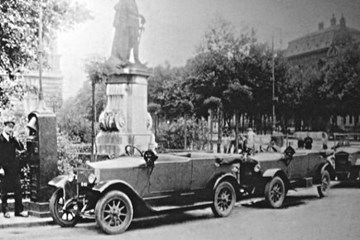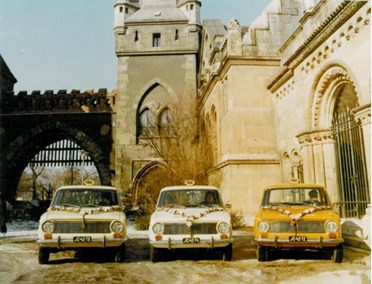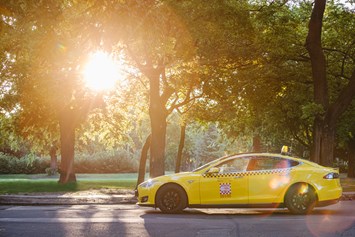History of Főtaxi
THE START
Főtaxi Zrt. is the largest taxi company in Hungary, which dates back more than 100 years. Its legal predecessor, Budapesti Automobil Közlekedési Rt. was founded in 1913, as the first taxi company in the country and the seventh in Europe. Also this year began the construction of the headquarters in district VIII on Kerepesi út 15, which is still home to Főtaxi Zrt.
The establishment of the company made it possible for Budapest's automobile traffic to develop at the turn of the century, and for the motor vehicle to become part of everyday life. The founder of Főtaxi and the company’s specialists have adapted and further developed international technical trends in order to bring the taxi network of the capital up to the technical and motorization standards of the era. In addition to transportation the huge industrial company also provided complete maintenance and repair of vehicles.

In the early years of taxiing, Marta-type cars first travelled the roads, and then the company later placed on the market Fiats in addition to the Magomobiles, dubbed the "lollipop."
The promisingly growing business almost came to a close in World War I, but thanks to developments and introduced innovations (Drost system, car wash, car repair school, two-person carts, etc.), interest in taxis has grown faster and faster year by year: only eighteen orders were received in October 1921, three years later, more than two hundred calls were routed through a telephone exchange, and the number rose rapidly to 4,500 by the early 1940s.
From 1941 the telephone number of the taxi was 22 22 22, this was kept over the years by the company, the current number of Főtaxi is 222 2 222.
In the 1920s, the Drost system was developed on the basis of an invention purchased in 1915, named after Drost Tivadar, more precisely Theodor Drost, a Hamburg engineer. Thus, Budapest was one of the first in the world to order a taxi at taxi ranks.
AFTER THE WORLD WAR II
After the war Autótaxi Rt. continued to operate under the name MOGÜRT Autótaxi Nemzeti Vállalat with 122 cars. At that time, privately held taxi licenses were gradually withdrawn so the Autótaxi company dominated the entire market.
In 1947, the company renewed its fleet with Renault-type cars and the red-and-white dice line first appeared on these cars as a distinctive sign.
The company was taken over by the state in March 1948 and then by the Metropolitan Council in 1952, when it was renamed to Fővárosi Autótaxi Vállalat.
By 1960, the car fleet had risen to over 900 and the number of taxi ranks equipped with telephones had reached 100. In the 60’s the development of the Autotaxi company accelerated significantly. The growing demands required the construction of new sites, the expansion of the scope of activities, and the expansion of the telephone exchange and the building at Kerepesi út.
To celebrate its 60th anniversary taxis were equipped with VHF devices to raise the standard of service. These taxis acted as mobile traffic control points, constantly cruising the streets to monitor needs and take immediate action. More than 2,500 trained drivers and nearly 1,500 cars were able to be marketed during peak hours.
From 1982, the company's monopoly position in the taxi market was abolished and private taxis appeared on the roads.

AFTER THE CHANGE OF RESIME
Főtaxi Zrt. was established in 1993.
In recent years, profile cleaning has taken place, and the classic car rental business has been replaced by long-term leasing. Currently, the taxi service is provided in a franchise system adapted to market requirements.
NOWADAYS

The year 2010 was decisive in the life of the company, as Főtaxi won the airport tender announced by Budapest Airport, so since December 7, 2010 Főtaxi can be the only official partner to transport passengers between the airport and the capital.
In recent years, as part of the company’s program “Zöldút”, the number of Főtaxi cars with green license plates has grown rapidly (now well over two hundred), including not only Nissans, Mercedes and KIAs, but in recent years Tesla models that have been spreading like wildfire are also represented.
Főtaxi is constantly examining what new opportunities and technologies we can incorporate into the taxi industry and the mobility ecosystem of Budapest in the changed mobility environment for a sustainable future.


